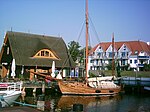Barth, Germany
1250s establishments in the Holy Roman Empire1255 establishments in EuropePopulated coastal places in Germany (Baltic Sea)Populated places established in the 13th centuryTowns in Mecklenburg-Western Pomerania ... and 1 more
Vorpommern-Rügen

Barth is a town in Mecklenburg-Vorpommern in north-eastern Germany. It is situated at a lagoon (Bodden) of the Baltic Sea facing the Fischland-Darss-Zingst peninsula. Barth belongs to the district of Vorpommern-Rügen. It is close to the Western Pomerania Lagoon Area National Park. In 2011, it held a population of 8,706.
Excerpt from the Wikipedia article Barth, Germany (License: CC BY-SA 3.0, Authors, Images).Barth, Germany
Weidenweg,
Geographical coordinates (GPS) Address Nearby Places Show on map
Geographical coordinates (GPS)
| Latitude | Longitude |
|---|---|
| N 54.366666666667 ° | E 12.716666666667 ° |
Address
Weidenweg 7a
18356
Mecklenburg-Vorpommern, Germany
Open on Google Maps









